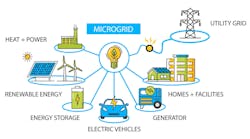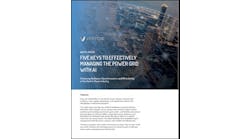The coronavirus (COVID-19) could alter who needs reliable energy — and when — and place new importance on residential microgrids.
An estimated 56% of the workforce is working from home during the pandemic. By goodluz/Shutterstock.com
While it’s too soon to gauge energy trends after society emerges from isolatation, short-term indicators may offer clues.
For one, we’re seeing what it means when a significant portion of the US population makes home their workplace.
Before COVID-19, about 5 million people, or 3.6% of the workforce, worked from home, according to Global Workplace Analytics’ analysis of 2018 American Community Service (ACS) data.
Now with as many as 56% of workers operating from home, skeptical employers are forced to test the approach. Kate Lister, president of the analytics firm, believes many will see the advantages and continue the practice.
How many will keep working from home after COVID-19?
“Our prediction is that the longer people are required to work at home, the greater the adoption we will see when the dust settles. We believe, based on historical trends, that those who were working remotely before the pandemic, will increase their frequency after they are allowed to return to their offices,” Lister said.
She estimates that work-at-home employees could grow from 3.6% to 25-30% of the workforce within the next two years.
This could shift the energy landscape meaningfully, given that Lister estimates a home-based worker adds 3,000 kWh per year to household electricity use, a significant uptick. Average annual consumption for a US household is about 11,000 kWh.
Innowatts, which provides AMI-enabled predictive analytics for the power industry, offers some additional insight.
The company’s data science team noted a 6-8% daily increase in residential demand due to COVID-19 isolation practices and a 25% drop in energy use by commercial buildings.
“The full impact of these shifts is yet to be determined,” wrote Siddhartha Sachdeva, founder & CEO at Innowatts on LinkedIn. “It’s a scenario new to all of us…”
Reports from grid operators also suggest that the large influx of home workers are reconfiguring electric demand patterns.
Everyday a snow day
ISO New England said that energy use patterns suddenly “resemble those of snow days, when schools are closed and many are home during the day.” Electric use is ramping up slower than normal in the morning, and increasing in the afternoon.
PJM yesterday reported a similar phenomenon. On March 17–19 the morning peak arrived one to two hours later than usual, shifting from about 8 am to 9–10 am. The load curve also was flatter, without the bump in the morning when people get ready for work and evening when they prepare dinner.
If the home becomes a greater economic engine as Global Workplace Analytics predicts, such shifts will be scrutinized more closely, and will likely to influence grid planning. And we may need to rethink who requires reliable energy and when. Household power outages would morph from minor inconveniences into actual economic lost. Calculations now used to justify the cost-effectivness of commericial and industrial microgrids would apply to residential microgrids.
Residential microgrids off the novelty shelf?
Our sudden shift to working at home comes at an interesting time for residential microgrids. Until recently they were largely a novelty, with the energy industry instead focusing on installing microgrids for businesses, government, military, institutions, utilities and communities. That’s begun to change with the decline in solar and battery costs, which have made home-based systems more affordable. Recent residential microgrid projects of note include:
- Affordable home microgrids being built for veterans in California
- A remote Oregon community that found it less expensive to go off grid
- A solar/storage microgrid project for an affordable apartment complex in Washington, DC
- LO3 Energy’s blockchain microgrid in Brooklyn continues to evolve
Dramatic events invitably reshape society’s priorities. The home, and its energy sources, could get much greater scrutiny following this pandemic. The time may be here for the residential microgrid.
Track news and trends about microgrids by subscribing to the free Microgrid Knowledge newsletter.







